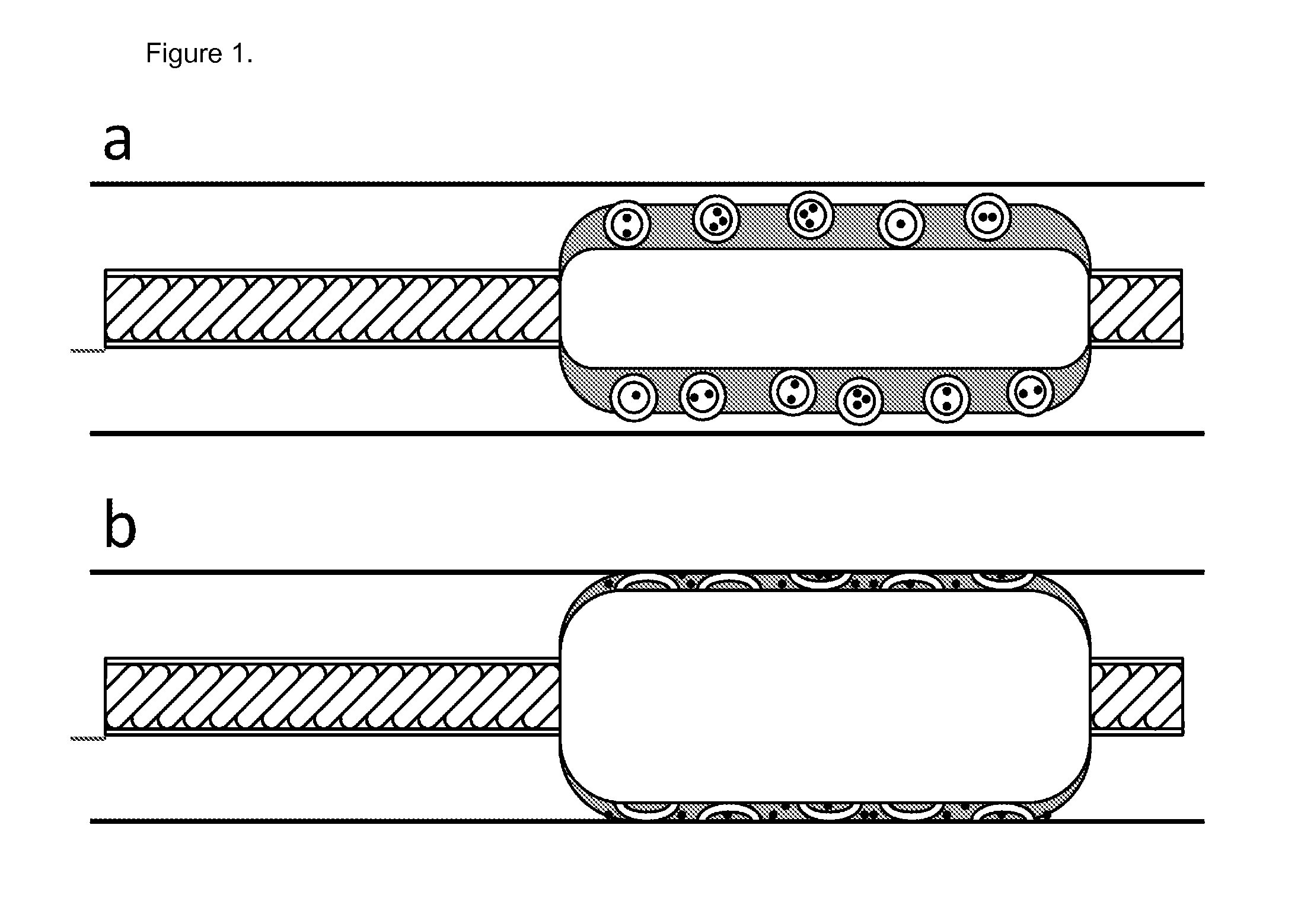Balloon catheter comprising pressure sensitive microparticles
a technology of balloon catheter and microparticle, which is applied in the direction of catheters, diaphragms, medical devices, etc., can solve the problem that a part of the therapeutic compound may be flushed away by the blood
- Summary
- Abstract
- Description
- Claims
- Application Information
AI Technical Summary
Benefits of technology
Problems solved by technology
Method used
Image
Examples
example 1
[0030]Microparticles of poly(methyl urea) were prepared following the procedure described by E. N. Brown et al. in J. Microencapsulation, 20, 719-730 (2003).
[0031]In general, a suitable method for the preparation of poly(methyl urea) microparticles is to dissolve urea (5.0 g, 83 mmol), ammonium chloride (0.5 g, 9.5 mmol) and resorcinol (0.5 g, 4.5 mmol) in a 2,5% (w / w) solution of poly(ethylene-alt-maleic anhydride) in water (200 ml). The pH may be raised from 2.44 to 3.70 by dropwise addition of a 0.1 M NaOH solution and, subsequently, lowered to 3.50 using a 0.1 M HCl solution.
[0032]The aqueous solution was agitated with an Ultra-Turrax at 15,200 rpm and a few droplets of 1-octanol were added to eliminate foam formation. A slow stream of paraffin containing a minute amount of Oil-Red-O was added to form an emulsion. The high speed stirring with the Ultra-Turrax was continued for 5 minutes in order to stabilize the emulsion.
[0033]Afterwards, the emulsion was transferred to a beaker...
example 2
[0036]Poly(ε-caprolactone) microparticles containing paclitaxel and (D+)-camphor were prepared in an oil-in-water emulsion. To generate this emulsion, a solution of poly(ε-caprolatone) (400.6 mg, 0.030 mmol), D(+)-camphor (1.20 g, 7.88 mmol) and paclitaxel (80.4 mg, 0.094 mmol) in dichloromethane (8 mL) was added slowly to an aqueous solution of poly(vinyl alcohol) (4% (w / v), 80 mL) and homogenized at 6,000 rpm for 5 minutes. Subsequently, the emulsion was continually stirred for 18 hours to allow complete evaporation of dichloromethane. The microparticles were collected by centrifugation (4,000 rpm, 5 minutes) and washed with distilled water twice. The obtained capsule dispersion was flash frozen and lyophilized for 48 hours to remove all volatiles and sublime D(+)-camphor from the microparticles.
[0037]These microparticles are fully degradable and release the paclitaxel they encapsulate upon degradation. They may be incorporated in a coating on top of a catheter balloon, such as a ...
example 3
[0038]A solution of poly(D,L-lactic acid) (801.5 mg, 0.067 mmol), D(+)-camphor (203.3 mg, 1.34 mmol) and paclitaxel (160.4 mg, 0.19 mmol) in dichloromethane (10 mL) was added slowly to a 5% (w / v) solution of poly(vinyl alcohol) in distilled water (100 mL) and homogenized at 4000 rpm for 5 minutes. Afterwards, the formed oil-in-water emulsion was continued stirring for 18 hours to evaporate dichloromethane and harden the microparticles. The microparticles were isolated by centrifugation (4000 rpm, 5 minutes) and washed with distilled water twice. A dispersion of the microparticles in water was flash frozen and lyophilized for 48 hours.
[0039]These microparticles are fully degradable and release the paclitaxel they encapsulate upon degradation. They may be incorporated in a coating on top of a catheter balloon such as a polyurethane coating and when pressure is applied they release the encapsulated paclitaxel. The poly(lactic acid) microparticles surprisingly released their content mor...
PUM
| Property | Measurement | Unit |
|---|---|---|
| diameter | aaaaa | aaaaa |
| diameter | aaaaa | aaaaa |
| temperature | aaaaa | aaaaa |
Abstract
Description
Claims
Application Information
 Login to View More
Login to View More - R&D
- Intellectual Property
- Life Sciences
- Materials
- Tech Scout
- Unparalleled Data Quality
- Higher Quality Content
- 60% Fewer Hallucinations
Browse by: Latest US Patents, China's latest patents, Technical Efficacy Thesaurus, Application Domain, Technology Topic, Popular Technical Reports.
© 2025 PatSnap. All rights reserved.Legal|Privacy policy|Modern Slavery Act Transparency Statement|Sitemap|About US| Contact US: help@patsnap.com


